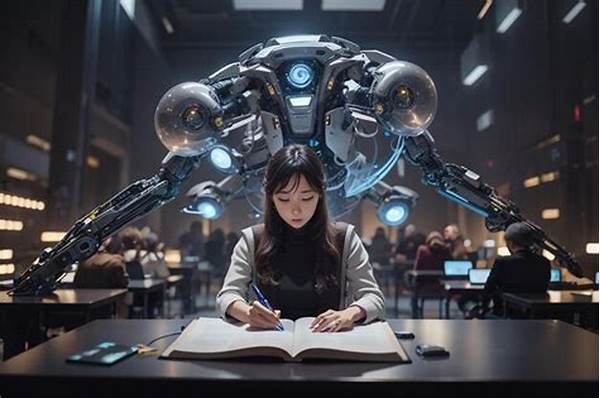Artificial intelligence (AI) is transforming industries across the globe, reshaping how we interact, interpret, and innovate. In the realm of creative storytelling, AI is not just a tool but a synthesized partner working alongside human imagination to craft narratives that resonate, engage, and inspire. As we stand on the cusp of a new era, it’s vital to explore the potential AI holds in this dynamic field. This synergy between artificial intelligence and creativity isn’t just a futuristic fantasy; it’s happening now, and its implications are profound.
Read More : Why Ai Photo Editing Tools Are Exploding In 2025
Imagine a world where you can tell your AI assistant about a vague idea for a story, and it helps flesh out the details, creating characters, plot twists, and emotional depth that captivate your audience. Sounds like science fiction? Welcome to the future of AI in creative storytelling. Emerging AI technologies are capable of analyzing vast reservoirs of data, understanding narrative structures, and predicting storytelling trends, enabling creatives to focus on the unique human touch that AI can never replicate.
However, the collaboration of AI in creative storytelling comes with its set of challenges and ethical questions. Can a machine truly capture the essence of human emotion? How do we ensure diversity in stories generated by AI? These questions urge us to consider AI as an ally rather than a replacement, guiding us to maintain a balance between technological advancement and authentic human expression.
For now, the urgency lies in understanding that the future of AI in creative storytelling is not just about enhancing productivity or automating tasks. It’s about co-creating stories that reflect our shared humanity. As AI developers and storytellers continue to navigate this exciting landscape, they innovate ways to use AI ethically and creatively, continuously redefining the essence of storytelling itself.
Collaborating with AI for Richer Narratives
As we delve deeper into the implications of AI in storytelling, the potential for richer, more layered narratives becomes evident. AI offers creatives the ability to simulate various scenarios, generating diverse storylines that may have been overlooked by the human mind. Furthermore, AI can analyze existing stories, offering insights into what elements captivate audiences most and why.
—
In the rapidly evolving landscape of technological innovation, one of the most compelling developments is the incorporation of artificial intelligence into the arts. More specifically, the future of AI in creative storytelling is charting new territories—where AI assists writers, filmmakers, and artists to transform the very fabric of narrative construction. Let’s explore why this integration is not just necessary but elemental for the future of storytelling.
Enhancing Human Creativity
At its core, the integration of AI into storytelling aims to amplify human creativity. Imagine an artist having a creative block; AI can provide alternative scenarios, suggest narrative arcs, or generate dialogue in varied tones. This collaborative process does not replace the creator but enhances their ability to produce enriched content.
Breaking Down Complex Data
Another primary goal is using AI’s capability to handle complex datasets. Storytellers can leverage AI to analyze audience preferences or compile historical data that helps craft authentic period narratives. With AI taking on the heavy lifting of data analytics, creators can focus their energies on refining their creative vision.
A crucial component of the future of AI in creative storytelling is accessibility. AI tools can democratize the storytelling process, allowing individuals without traditional training to create compelling stories. With user-friendly interfaces and intuitive functions, even aspiring storytellers can craft narratives that might have been daunting otherwise.
A point of emphasis is tapping into global narratives. AI has the potential to transcend geographical and cultural boundaries, suggesting themes and constructs that resonate universally. Creators can weave global tales that speak to collective human experiences, fostering a sense of unity through shared narratives.
Finally, another goal is ethical storytelling—ensuring that AI-generated content is inclusive and reflective of diverse perspectives. Developers and creatives must work hand-in-hand to ensure that the biases present in training data do not perpetuate in the stories being told. This commitment to ethical storytelling paves the way for richer, more inclusive narratives in the future of AI in creative storytelling.
Steps Towards a Seamless AI Integration in Storytelling
The Synergy Between AI and Human Creativity
While AI can sift through endless possibilities, the heart of storytelling is inherently human. AI’s role in storytelling is to amplify and complement human creativity, not supplant it. Understanding this dynamic is crucial, as the onset of AI in creative storytelling does not spell the end of human narratives but rather a new beginning.
—
The world of creative storytelling is set to undergo a dramatic transformation with the infusion of AI. The possibilities are endless, promising a tapestry of narratives that weaved with precision, empathy, and innovation. As we continue to embrace the future of AI in creative storytelling, understanding its dynamics, potential, and ethical considerations remain crucial for storytellers and technologists alike.
A New Horizon in Story Creation
Within the next decade, stories co-created with AI could become mainstream, making it a fertile ground for experimentation and innovation. This new horizon not only challenges traditional storytelling paradigms but also extends the narrative canvas to encompass a wider array of genres and experiences.
Integrating AI with creative storytelling is neither a distant dream nor a simple task. It requires continuous learning, adaptation, and ethical vigilance. As technology evolves, so must our understanding of its capabilities and limitations. The goal remains to ensure that the future of AI in creative storytelling is inclusive, diverse, and reflective of the depth of human emotion and experience.
The exciting journey of AI in storytelling invites everyone—creatives, technologists, and audiences—to engage with stories like never before. With AI as a partner, storytellers can envision a future where narratives are dynamic, personalized, and resonant. Now is the time to embrace the tools of tomorrow and forge a path where both AI and human creativity flourish.
As we chart this path, it’s imperative that discussions around ethics, accessibility, and inclusivity remain at the forefront. These considerations will define not only the technological landscape but the cultural narratives that shape our worldviews. The future of AI in creative storytelling is bright, but it’s our collective responsibility to guide it toward a place of ethical integrity and creative abundance.
The Promise and Challenges
The fusion of AI and creative storytelling is not without its challenges. Questions around authorship, originality, and depth continue to arise. However, with challenges come opportunities to rethink, reshape, and reinvent the ways stories are crafted and consumed. As we move forward, understanding AI’s potential and limitations will be key in harnessing it as a tool for artistic exploration and narrative excellence.
Anticipating the Next Chapter
The future is ripe with potential, and it’s an exhilarating time for creatives and technologists to join forces in shaping a narrative-rich world powered by AI. The future of AI in creative storytelling is not just about technology’s role as a tool but as an enabler for deeper connection, understanding, and storytelling evolution.
—
This article not only highlights the potential AI holds for the creative storytelling sector but also emphasizes the importance of a collaborative, ethical approach to future applications. With AI molding tomorrow’s narratives, the story we tell today is of innovation, responsibility, and boundless opportunity.


